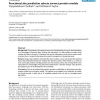Free Online Productivity Tools
i2Speak
i2Symbol
i2OCR
iTex2Img
iWeb2Print
iWeb2Shot
i2Type
iPdf2Split
iPdf2Merge
i2Bopomofo
i2Arabic
i2Style
i2Image
i2PDF
iLatex2Rtf
Sci2ools
BMCBI
2008
2008
Functional site prediction selects correct protein models
Background: The prediction of protein structure can be facilitated by the use of constraints based on a knowledge of functional sites. Without this information it is still possible to predict which residues are likely to be part of a functional site and this information can be used to select model structures from a variety of alternatives that would correspond to a functional protein. Results: Using a large collection of protein-like decoy models, a score was devised that selected those with predicted functional site residues that formed a cluster. When tested on a variety of small // type proteins, including enzymes and non-enzymes, those that corresponded to the native fold were ranked highly. This performance held also for a selection of larger // proteins that played no part in the development of the method. Conclusion: The use of predicted site positions provides a useful filter to discriminate native-like protein models from non-native models. The method can be applied to any co...
| Added | 09 Dec 2010 |
| Updated | 09 Dec 2010 |
| Type | Journal |
| Year | 2008 |
| Where | BMCBI |
| Authors | Vijayalakshmi Chelliah, William R. Taylor |
Comments (0)

